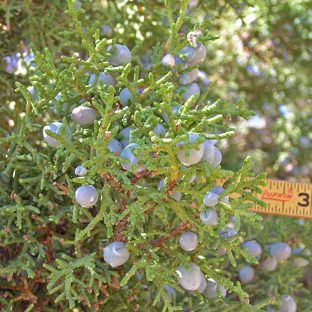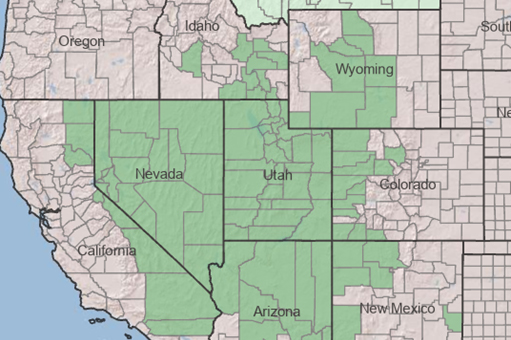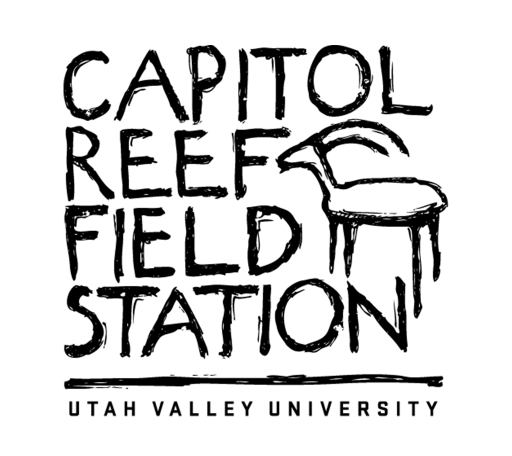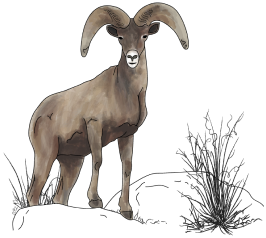Juniperus osteosperma (Torr.) Little
Viridiplantae > Streptophyta > Streptophytina > Embryophyta > Tracheophyta > Euphyllophyta > Spermatophyta > Acrogymnospermae > Pinopsida > Pinidae > Conifers II > Cupressales > Cupressaceae > Juniperus > Juniperus osteosperma [1]
![Photo taken Feb 2012 by Richard W. Spjut [19].](/crfs/images/native-plants/plant-directory/utahjuniper-first.jpg)
Photo taken Feb 2012 by Richard W. Spjut [19].
Monoecious shrubs or small trees, usually with 1 to several branches from the ground, 2-4(-6) m tall, the trunks to 1 m thick or more, crown rounded; branchlets stout, ca 2 mm thick; bark usually gray, thin, fibrous, ultimately shredded. Leaves typically opposite, sometimes in 3’s, the scalelike ones (0.5)1-3 mm long, yellowish-green, denticulate on the margins, the dorsal resin gland not apparent; young leaves at branch tips awl-shaped, sharp, 2-8 mm long, decurrent. Staminate cones yellowish-brown, 3-4 mm long. Ovulate cones subglobose, 6-13 mm wide, brownish or blue to blue-purple at maturity, glaucous, succulent but of bad flavor when fresh. Seeds 1(2) per cone [2].
![Photo taken April 23, 2008 by Al Schneider [17].](/crfs/images/native-plants/plant-directory/utahjuniper-sec.jpg)
Photo taken April 23, 2008 by Al Schneider [17].
Junipuerus osteosperma can be confused with Juniperus scopulorum (Rocky Mountain Juniper), with which it overlaps in distribution. Juniperus osteosperma is monoecious (has both male and female cones on the same plant) whereas J. scopulorum is dioecious; osteosperma has more yellow-green needles, gray bark, and a broad, rounded to open tree crown as opposed to scopulorum’s blue-green needles, reddish-brown bark, and pyramidal to rounded tree crown. Juniperus osteosperma has larger and more stout shoots that are 1.5-2 mm wide and somewhat upright versus scopulorum’s 0.7 - 1.2 mm wide shoots that tend to droop; osteosperma has larger berries that are 7-13 mm in diameter as opposed to scopulorum’s 5-9 mm in diameter [3]. Juniperus osteosperma can be distinguished from Juniperus monosperma (One-seed Juniper) by its more open appearance and lack of a resin gland on the side of its leaves; monosperma has this resin gland produces an aromatic, sticky, white, crystalline exudateon its young leaves [4].
The Utah Juniper, Juniperus osteosperma, was first collected near Williams, AZ by botanist John M. Bigelow during the 1853 Whipple expedition whose purpose was to determine the best railroad route from the Mississippi to the Pacific and named Juniperus tetragona var. osteosperma Torr. in 1857 [15]. It was later raised to specific status in 1948 [16].

Photo taken June 10, 2004 by Al Schneider [18].
A wax on the fruit is obtained by simmering the fruit in hot water and skimming off the wax as it rises to the surface. The wax can be used to make aromatic candles [6]. The plants aromatic and volatile compounds make it good for use as an incense and fumigant [7]. An infusion of the plant has been used as a hair wash [7]. Utah Juniper wood does not readily decay and is used particularly for fence posts [8]. This species is important to wildlife for cover and food and is used by many birds and wildlife including large and small mammals [8].
Utah Juniper berries have a thin flesh that is sweet but strongly flavored of resin with a mealy texture; they may be eaten raw, cooked, or dried and ground into a flour [9]; they can be used as a flavoring in stews and on meats [7]. Some have purported no known hazards to eating juniper berries [10] although the berries contain Thujone, a chemical that may cause kidney problems in high concentrations [11].
Juniperus osteosperma was widely employed medicinally by North American tribes who used it to treat a number of ailments including as a decoction used to treat constipation [12], bladder and kidney issues [7], a poultice of leaves applied to the jaw to treat toothaches and sore or swollen gums or joints for rheumatism; a decoction of young twigs for the treatment of stomach aches, kidney complaints, hemorrhages, coughs and colds; fumes from burning twigs inhaled for headaches and colds; a strong decoction used as an antiseptic wash on sores; a poultice of mashed twigs as a dressing on burns and swellings [7]. The seeds are said to be analgesic and eaten to sooth headaches or menstrual cramps [7]. Havasupai crushed the bark to be used as a 'slow match.' where the crushed bark was twisted into rope, tied at intervals with yucca thread and wrapped into a coil. The free end was set on fire and kept smoldering by blowing on it at intervals. Fire could be carried in this fashion from early dawn until noon [7].

[13]
Utah Juniper (Juniperus osteosperma) has most recently been assessed for The IUCN Red List of Threatened Species in 2011 as Least Concern [14].
This plant can be found in warm and cool desert biomes, and is localized to riparian, mixed warm and cool desert shrub, sagebrush, juniper, pinyon-juniper, ponderosa pine, and aspen communities between 850 and 2440 m in its native range [2].
[1] "Taxonomy Browser (Juniperus osteosperma)." National Center for Biotechnology Information, www.ncbi.nlm.nih.gov/Taxonomy/Browser/wwwtax.cgi.
[2] Welsh, S. L. A Utah flora. 3rd ed., Brigham Young University Press, 2003. ISBN 0-8425-2556-4
[3] Schneider, Al. "Southwest Colorado Wildflowers, Juniperus scopulorum and deppeana." Southwest Colorado Wildflowers, www.swcoloradowildflowers.com/Tree%20Enlarged%20Photo%20Pages/juniperus%20scopulorum%20and%20deppeana.htm.
[4] Schneider, Al. "Southwest Colorado Wildflowers, Juniperus monosperma." Southwest Colorado Wildflowers, www.swcoloradowildflowers.com/Tree%20Enlarged%20Photo%20Pages/juniperus%20monosperma.htm.
[5] "OLDLIST, a database of old trees." Rocky Mountain Tree-Ring Research, www.rmtrr.org/oldlist.htm.
[6] Harrington. H. D. Edible Native Plants of the Rocky Mountains. University of New Mexico Press 1967 ISBN 0-8623-0343-9
[7] Moerman, Daniel E. 1998. Native American Ethnobotany. Timber Press, Oregon
[8] Sturla, Eugene. "Juniperus Osteosperma, Utah Juniper, Southwest Desert Flora." Southwest Desert Flora, southwestdesertflora.com/WebsiteFolders/All_Species/Cupressaceae/Juniperus%20osteosperma,%20Utah%20Juniper.html.
[9] Sargent. C. S. 1965. Manual of the Trees of N. America. Dover Publications Inc. New York.
[10] Fern, Ken. "Juniperus osteosperma - (Torr.) Little." Plants for a Future, pfaf.org/user/Plant.aspx?LatinName=Juniperus+osteosperma
[11] Brown, A.C., 2017. Kidney toxicity related to herbs and dietary supplements: Online table of case reports. Part 3 of 5 series. Food and Chemical Toxicology, 107, pp.502-519.
[12] Whiting, Alfred F. 1939. Ethnobotany of the Hopi. North Arizona Society of Science and Art.
[13] USDA NRCS National Plant Data Team. "Juniperus osteosperma (Torr.) Little Plant Profile." USDA Plants Database, plants.usda.gov/home/plantProfile?symbol=JUOS.
[14] "Juniperus osteosperma Red List Assessment." IUCN Red List of Threatened Species, https://www.iucnredlist.org/species/42241/2965708
[15] "Juniperus osteosperma (Torr.) Little." Tropicos, Missouri Botanical Garden, tropicos.org/name/9400345.
[16] Eastwood, Alice, and John T. Howell. 1948. Leaflets of Western Botany, 5(8): 125
[17] Schneider, Al. "4saos.jpg." Photograph. Southwest Colorado Wildflowers, 23 Apr. 2008, www.swcoloradowildflowers.com/Tree%20Enlarged%20Photos/4saos.jpg.
[18] Schneider, Al. "3saos.jpg." Photograph. Southwest Colorado Wildflowers, 10 Jun. 2004, www.swcoloradowildflowers.com/Tree%20Enlarged%20Photos/3saos.jpg.
[19] Spjut, Richard W. "Junip osteosper m 16866 155.jpg." Photograph. World Botanical Associates, Feb. 2012, www.worldbotanical.com/images/Juniperus/Junip_osteosper-m-16866-155.jpg.



